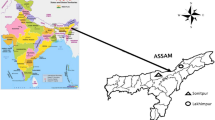Abstract
In south Meghalaya, farmers maintain a variety of economically important plant species in arecanut agroforestry systems. We investigated plant species composition of arecanut agroforests of south Meghalaya and encountered 160 plants, which included 83 tree species, 22 shrub species, 41 herb species and 14 climber species. The study reveals that arecanut agroforests provide cash income, medicine, timber, fuelwood and edibles for household consumption as well as for sale. We conclude that these agroforestry systems serve as home for many economically important plant species, harbour rich biodiversity and mimic the natural forests both in structural composition as well as ecological and economic functions.
Similar content being viewed by others
References
Balakrishnan NP. 1981–1983. Flora of Jowai, Meghalaya, Vol. I & II. Botanical Survey of India, Howrah. 666 pp.
Collins SL, Glenn SM, Gibson DJ. 1995. Experimental analysis of intermediate disturbance and initial floristic composition: decoupling cause and effect. Ecology, 76: 486–492.
Connell JH. 1978. Diversity in tropical rain forest and coral reefs. Science, 199: 1302–1310.
Ehrlich PR, Wilson EO. 1991. Biodiversity studies: science and policy. Science, 253: 758–762.
Jamir SA, Pandey HN. 2003. Vascular plant diversity in the sacred groves of Jaintia Hills in northeast India. Biodiversity and Conservation, 12: 1497–1510.
Kanjilal UN, Kanjilal PC, Das A, De RN, Bor NL. 1934–1940. Flora of Assam. 5 Vols. Shillong: Govt. press, 2230 pp.
Khan ML, Shaily M, Kamaljit SB. 1997. Effectiveness of the protected area network in biodiversity conservation, a case study of Meghalaya state. Biodiversity and Conservation, 6: 853–865.
Misra R. 1968. Ecology Work Book. New Delhi: Oxford and IBH, 244 pp.
Motiur RM, Furukava Y, Kawata I, Rahman M, Alam M. 2006. Role of homestead forest in household economy and factors affecting forest production: a case study in southwest Bangladesh. Journal of Forest Research, 11: 89–97.
Mueller-Doimbois D, Ellenberg H. 1974. Aims and Methods of Vegetation Ecology. New York: John Wiley, 547 pp.
Mukherjee N (ed). 1993. Participatory Methods and Rural Knowledge. Participatory Rural Appraisal Methodology and Applications. New Delhi: Concept Publishing Company, Pp. 40–47.
Pandey CB, Lata K, Avenkatesh A, Medhi RP. 2006. Diversity and species of home gardens in south Andaman. Tropical Ecology, 47: 251–258.
Pielou EC. 1975. Population and Community Ecology. Principles and Methods. New York: Gordon and Breach Science Publishers Inc., 423 pp.
Saha N, Azam MA. 2004. The indigenous hill-farming system of Khasia Tribes in Moulvibazar District of Bangladesh: status and impacts. Small-scale Forest Economics, Management and Policy, 3: 273–281.
Schroth G, da Fonseca GAB, Harvey CA, Gaston C, Vasconcelos HL, Izac A M (eds.). 2004. Agroforestry and Biodiversity Conservation in Tropical Landscapes. Washington, D.C: Island Press, 523 pp.
Shannon CE, Wiener W.1963. The mathematical theory of communication. University Illinois Press, Urbana, Pp. 360.
Simpson EH. 1949. Measurement of diversity. Nature, 163: 688.
Sonwa DJ, Nkongmeneck BA, Weise SF, Tchatat M, Adesina AA, Janssens MJJ. 2007. Diversity of plants in cocoa agroforests in the humid forest zone of Southern Cameroon. Biodiversity and Conservation, 16: 2385–2400.
Sorensen T. 1948. A method of establishing groups of equal amplitude in plant sociology based on similarity of species and its application to analyses of the vegetation on Danish commons. Biological Skrifer/Kongelige Danske Videnskabernes Selskab, 5: 1–34.
Takhtajan A. 1988. Floristic Region of the World. Bishen Singh Mahandra Pal Singh, Dehradun. Pp. 71–78.
Tiwari BK. 2005. Forest biodiversity management and livelihood enhancing practices of War Khasi of Meghalaya, India. In: Thomas, Y., Karki, M., Gurung, K. and Parajuli, D. (eds), Himalayan Medicinal and Aromatic Plants, Balancing Use and Conservation. Published by: His majesty Government of Nepal Ministry of Forests and Soil Conservation. Pp 240–255.
Tiwari BK, Tynsong H, Rani S. 2004. Medicinal and aromatic plants: Medicinal plants and human health. In: Burley J. J. Evans and Youngquist, J. A. (Eds), Encyclopedia of Forest Sciences. UK: Elsevier Ltd. Oxford, Pp. 515–523.
Tripathi OP, Pandey HN, Tripathi RS. 2006. Tree diversity and community characteristics of the sub-tropical evergreen forest in the buffer and core zones of Nokrek biosphere reserve, north-east India. In: Pandey, H.N. and Barik, S.K. (eds) Ecology, Diversity and Conservation of Plants and Ecosystems in India. New Delhi: Regency Publication, Pp. 217–233.
Tynsong H. 2009. Plant diversity and NTFP management in community forests of War area Meghalaya. Ph.D. Thesis. North-Eastern Hill University, Shillong-793022, India.
Upadhaya K. 2002. Studies on plant biodiversity and ecosystem function of sacred groves of Meghalaya. Ph.D. Thesis, North-Eastern Hill University, Shillong.
Author information
Authors and Affiliations
Corresponding author
Additional information
The online version is available at http://www.springerlink.com
Rights and permissions
About this article
Cite this article
Tynsong, H., Tiwari, B.K. Diversity of plant species in arecanut agroforests of south Meghalaya, north-east India. Journal of Forestry Research 21, 281–286 (2010). https://doi.org/10.1007/s11676-010-0072-5
Received:
Accepted:
Published:
Issue Date:
DOI: https://doi.org/10.1007/s11676-010-0072-5




